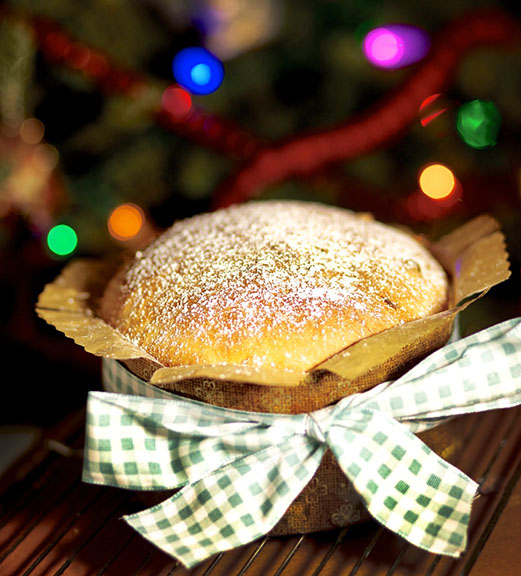 [T]his blog is devoted to certain recipes, tried and true; others, brand new. I love to try something I’ve never done before. The bread-of-the-month adventure reflects this, and with the end of 2013, I approached making a holiday bread I’d eaten many times but never made myself.
[T]his blog is devoted to certain recipes, tried and true; others, brand new. I love to try something I’ve never done before. The bread-of-the-month adventure reflects this, and with the end of 2013, I approached making a holiday bread I’d eaten many times but never made myself.

Each holiday season and in fact, in certain places all year long, one can find the Italian Panettone breads in their colorful boxes with ribbon handles. If you have dared and delighted to sample one of these creatures, you will discover a cylindrical sweet roll-type of bread, formed and baked in a paper mold, its egg-y richness studded with candied and dried fruits. It can be sliced and eaten plain or spread with butter — delicious for breakfast in this form or….made into French toast (a real treat). I have also turned extra Panettone — voluminous enough to have plenty of eating mileage — into a Christmas dessert of bread pudding. Extra yummy!
Having made a few rare and somewhat challenging bread recipes (including Stollen, King Cake and croissants), I dared myself to shun the pre-made versions and make Panettone this year. Why not? As Christmas approaches, my oven is going full speed. What’s one extra passenger or two?
One of my favorite things about Christmas time is all the stories connected to it. So it seems fitting that Panettone — much storied itself — intrigued me so. According to The Italian Bakerby Carol Field (1985), the name originated from the Milanese term “panett†for regular bread, so a larger, richer bread was called “panettone.†Still another tale points out that in the Middle Ages, there were bakers for the rich and bakers for the poor, and only at Christmas time did bakers for the poor make a more decadent bread with butter, eggs, sugar, raisins and candied fruit called “pan di tono.â€
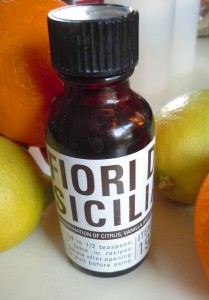
But the book also relates the most famous story of Panettone — the stuff of true romance! A Milanese noble fell in love with the daughter of a poor baker named Tony. He wanted to marry the daughter so badly, he suppled the means to buy all the best ingredients for Tony, including candied orange, citron and raisins for a bread that became “pan di Tonio,†which made the baker’s career and won the noble the daughter’s hand!
What led me to the Panettone recipes I ended up making was a single flavoring ingredient I found on the King Arthur Flour baking website. I had long been intrigued by Fiori di Sicilia, a blend of citrus and vanilla flavors, and when King Arthur promoted this as an essential flavoring for Panettone, I consulted the site’s recipes as my choice.
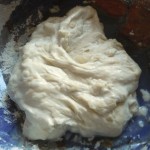 To let you know of my commitment here, please be aware that Panettone is not something you whip out in an hour or two…or even four. An “overnight†(8 to 12 hours) starter sponge is made to provide the texture and supposedly extended shelf life of the bread. Expect this starter or “biga†to be rather thick, almost like a dough in itself, but the fermenting process will make it somewhat spongier.
To let you know of my commitment here, please be aware that Panettone is not something you whip out in an hour or two…or even four. An “overnight†(8 to 12 hours) starter sponge is made to provide the texture and supposedly extended shelf life of the bread. Expect this starter or “biga†to be rather thick, almost like a dough in itself, but the fermenting process will make it somewhat spongier.
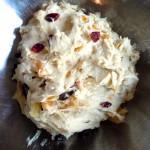 To also let you know how seriously, I took my Panettone making, I tried two different versions of the bread recipes from King Arthur’s site…they were only slightly different, ingredient-wise, and the process was virtually the same. The dough goes through two rising processes. The first rise (one recipe left the fruit out at this point, the other mixed it in) is in a large bowl, unmolded. This takes about an hour and a half.
To also let you know how seriously, I took my Panettone making, I tried two different versions of the bread recipes from King Arthur’s site…they were only slightly different, ingredient-wise, and the process was virtually the same. The dough goes through two rising processes. The first rise (one recipe left the fruit out at this point, the other mixed it in) is in a large bowl, unmolded. This takes about an hour and a half. 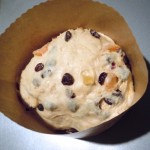 The second rise takes place in the paper mold in which panettone is usually baked. (To note here, the fruits I used in my Panettone breads were a range of my favorites, from dried apricots and pineapple, dried cranberries, and the zest of both a lemon and an orange.) It was with the second rise I discovered a bit of discrepancy with the King Arthur recipe, which claims the Panettone will reach the desired and adequate height in under two hours. I ended up giving the dough a rise of more than three hours to get to the appropriate volume. I was bleary eyed, as it was getting late, but when you commit to these things, you must follow through. Take some shots of Diet Mountain Dew and live with your decisions!
The second rise takes place in the paper mold in which panettone is usually baked. (To note here, the fruits I used in my Panettone breads were a range of my favorites, from dried apricots and pineapple, dried cranberries, and the zest of both a lemon and an orange.) It was with the second rise I discovered a bit of discrepancy with the King Arthur recipe, which claims the Panettone will reach the desired and adequate height in under two hours. I ended up giving the dough a rise of more than three hours to get to the appropriate volume. I was bleary eyed, as it was getting late, but when you commit to these things, you must follow through. Take some shots of Diet Mountain Dew and live with your decisions!
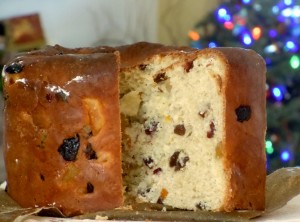 My finished Panettone breads baked up beautifully, filling the late-night household with a fruity, buttery aroma that I hope sent up signals to the bakers in those old stories (especially Tony) that their tradition was being humbly carried out in my strange kitchen.
My finished Panettone breads baked up beautifully, filling the late-night household with a fruity, buttery aroma that I hope sent up signals to the bakers in those old stories (especially Tony) that their tradition was being humbly carried out in my strange kitchen.
I have friends of Italian heritage, one telling me I was braver than she for even attempting Panettone. Here’s the even bolder thing — I served one of my Panettone loaves to both of these friends, a mother and son. I found the texture slightly drier and more crumbly than the Panettones I had purchased, but the flavor was spot-on. They were kind and complimentary and said my bread was the perfect thing with coffee.
Overnight Panettone
From King Arthur Flour (www.kingarthurflour.com)
Makes 1 loaf
This traditional Italian holiday bread will stay fresh longer when it’s made with an overnight starter.
Biga (Overnight Starter)
3/4 cup (3 1/8 ounces) King Arthur Unbleached All-Purpose Flour

1/16 teaspoon yeast (just a pinch)

1/3 cup (2 5/8 ounces) water

Dough

All of the biga (above)

2 1/4 cups (9 1/2 ounces) King Arthur Unbleached All-Purpose Flour

1/4 cup (2 ounces) water

2 large eggs

1/4 cup (1/2 stick, 2 ounces) unsalted butter

1 1/4 teaspoons salt

1/2 teaspoon Fiori di Sicilia flavoring OR 1 teaspoon vanilla + 1/8 teaspoon orange oil

2 1/4 teaspoons SAF Gold instant yeast OR 1 tablespoon instant yeast

1/3 cup (2 1/4 ounces) sugar

1/2 cup (3 ounces) golden raisins

1/2 cup (2 1/4 ounces) slivered dried apricots

1/2 cup (2 ounces) dried cranberries or flavored fruit bits

1/2 cup (2 1/2 ounces) dried pineapple, chopped

2 tablespoons orange or lemon zest
The Biga: Combine the biga ingredients in a medium-sized mixing bowl, cover, and allow them to rest overnight (8 to 12 hours).


Dough: Combine all of the dough ingredients except the fruit, and mix and knead them together—by hand, mixer or bread machine—till you’ve made a soft, smooth dough. Allow the dough to rise, covered, for 1 to 1 1/2 hours, or until it’s puffy (though not necessarily doubled in bulk). Gently deflate the dough, and knead in the fruits and zest.
 Shape the dough into a ball and place it in a panettone pan or other straight-sided, tall 1 1/2- to 2-quart pan. Cover the pan and let the dough rise till it’s just crested over the rim of the pan, about 1 hour. 

Bake the bread in a preheated 400°F oven for 10 minutes; reduce the oven heat to 375°F and bake an additional 10 minutes; then reduce the heat to 350°F and bake for 25 minutes, tenting with aluminum foil if the crust appears to be browning too quickly.
Remove the panettone from the oven and cool completely.
This recipe reprinted from The Baking Sheet Newsletter, Vol. III, No. 2, December 1991 issue.
Blogger’s Note: Depending on your baking conditions, the second rise of your dough may take longer — up to three hours — to reach adequate height. Watch your oven during baking time. Some of the reviews on the King Arthur Flour website said their breads baked in 20 minutes. I found mine got done altogether in just under 40 minutes.
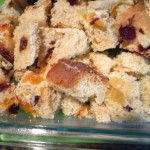 [S]hould you find yourself with leftover Panettone, whether you baked it yourself or purchased one, nothing I’ve found makes a better bread pudding. Bread pudding, I know, come into being as a way to stretch day-old or stale bread into another incarnation.
[S]hould you find yourself with leftover Panettone, whether you baked it yourself or purchased one, nothing I’ve found makes a better bread pudding. Bread pudding, I know, come into being as a way to stretch day-old or stale bread into another incarnation.  It is one of my favorite desserts, truly old-school and comforting. The texture and flavor of Panettone work perfectly here, soaking up the rich custard. I could think of a no more festive way than to end my Panettone experience, the fruity bread, bright with citrus flavor, meeting the rich egg-y custard I laced with cinnamon. Buon Natale…and Buon Anno!
It is one of my favorite desserts, truly old-school and comforting. The texture and flavor of Panettone work perfectly here, soaking up the rich custard. I could think of a no more festive way than to end my Panettone experience, the fruity bread, bright with citrus flavor, meeting the rich egg-y custard I laced with cinnamon. Buon Natale…and Buon Anno!
Panettone Bread Pudding with Cinnamon Syrup
Recipe by Giada De Laurentiis (www.foodtv.com)
Makes 8 servings
Cinnamon Syrup:
1 cup water
1 cup (packed) dark brown sugar
2 tablespoons whipping cream
1/2 teaspoon ground cinnamon
Bread Pudding:
Butter
1 (1-pound) loaf panettone bread, crusts trimmed, bread cut into 1-inch cubes
8 large eggs
1 1/2 cups whipping cream
2 1/2 cups whole milk
1 1/4 cups sugar
To make the syrup:
Combine 1 cup of water and brown sugar in a heavy medium saucepan. Bring to a boil over high heat, stirring until the sugar dissolves. Boil until the syrup reduces to 1 cup, about 10 minutes. Remove from the heat and whisk in the cream and cinnamon. Keep the syrup warm. (The syrup can be made 1 day ahead. Cool, then cover and refrigerate. Re-warm before serving.)
To make the bread pudding:
Lightly butter a 13 by 9 by 2-inch baking dish. Arrange the bread cubes in prepared dish. In a large bowl, whisk the eggs, cream, milk, and sugar to blend. Pour the custard over the bread cubes, and press the bread cubes gently to submerge. Let stand for 30 minutes, occasionally pressing the bread cubes into the custard mixture. (Can be prepared 2 hours ahead. Cover and refrigerate.)
Preheat the oven to 350 degrees F.
Bake until the pudding puffs and is set in the center, about 45 minutes. Cool slightly.
Spoon the bread pudding into bowls, drizzle with the warm Cinnamon Syrup, and serve.
Blogger’s Note: I normally do not make the Cinnamon Syrup in this recipe, but instead add about 1/2 to 3/4 teaspoon of ground cinnamon to the custard. I top each serving of bread pudding with some whipped cream.
